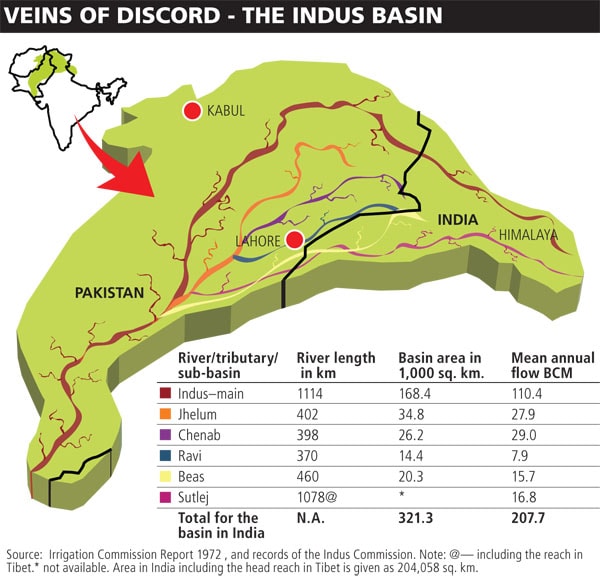
Whose Water Is It Anyway?
India's disputes with its neighbours for water will escalate in the near future unless it begins to work with them to develop joint ventures for equitable sharing
Early this year, extremists in Pakistan found a new issue to bait India with. Hafiz Saeed, founder of Jamaat-ud-Dawa, widely considered to be a front for the Lashkar-e-Toiba, rallied worshippers in Lahore saying India was guilty of ‘water terrorism’. He also led protesting farmers carrying signs that said, “Water flows or blood.”
The issue managed to touch a chord among many ordinary people because Pakistan is faced with its most severe shortage of water since Independence, in spite of the recent floods that have wreaked havoc in the country. Dry spells in the past few years have seen bitter conflicts within the country: Southern Pakistan accuses the north of grabbing more than its share of water. But most in the north blame India for stealing water.
Even as India and Pakistan negotiate equitable sharing of water, the Pakistan prime minister is having an equally tough time settling similar conflicts between the states of Sindh and Punjab. All this has led to forceful opposition to India’s plans to build a hydropower project on the Kishanganga (called Neelum in Pakistan). Pakistan claims the project will violate the 1960 Indus Waters Treaty between the two countries and will lead to a 27 percent water deficit.
Around the same time Saeed was rallying farmers, another lobby group, the Lahore Chamber of Commerce, made a presentation to a delegation from the local US consulate spelling out the scenario in the starkest terms: “It can result in confrontation between two nuclear states,” one slide said. Another warned that “No water means poverty, hunger, war.”
John Briscoe, professor of the practice of environmental health at Harvard School of Public Health, has spent 35 years in the World Bank studying water-related disputes around the world. He points out that large agricultural areas and most cities in the subcontinent depend heavily on groundwater, which is going down at an alarming rate. In India, the affected areas such as Punjab, Haryana, Delhi, Rajasthan, Gujarat, Maharashtra and Tamil Nadu are critical for food production.
Pakistan faces similar daunting problems. The Indus is likely to be much more seriously affected by climate change than any other river system in South Asia. Briscoe is convinced that unless there are major reforms in the way it is managed, water is likely to become a major constraint for economic growth and human wellbeing.
Indian policy makers acknowledge that the situation is grim. India is already below the water stress level, which requires availability of 1,700 cubic metres of water per person. Water resources secretary U.N. Panjiar says, “after best efforts to improve water use efficiency are undertaken, India is projected to have just 1,100 cubic metres per capita by 2050,”
Despite this, the government while listing out a long list of steps planned for the future like the National Water Mission, appears to be in denial when it comes to actual water diplomacy.
In the water ministry, the focus is on managing demand by adopting best practices. The government’s primary focus has been improving the water use efficiency in agriculture either through better irrigation models or with water-efficient seed and farming systems.
While Panjiar is aware that climate change is likely to have huge impact on India’s overall water availability, he says there is no quantitative assessment of the repercussions. There is also no plan to forge a partnership with neighbouring countries on water in the foreseeable future.
An example is the lack of diplomatic push in concluding projects like the High Dam on Kosi river or the Mahakali Treaty with Nepal. Though the projects would be beneficial to both countries, India has failed to sort them out even after almost two decades.
Other countries have a better record. In South America, Brazil has managed to solve long-standing water issues with Paraguay as well as Argentina. Closer home, Laos and Thailand have been able to find a sustainable solution to share waters.
Of the five SAARC (South Asian Association for Regional Cooperation) nations with whom India is sparring on water, it has resolved the problem only with Bhutan by helping the mountain kingdom develop hydro-electric power. Professor Briscoe says, “With similar maturity on both sides arrangements can be made on generating and sharing benefits with Pakistan, Nepal, China and Bangladesh.’’
He says that the most critical case is Pakistan and is critical of the Indian government’s handling of the situation and calls for magnanimity. “Unless both countries find ways of moving beyond mutual recriminations and tit-for-tat point-scoring, the vital Indus Water Treaty will be under threat,’’ he says.
There are great benefits to both countries in cooperating on the Indus. For Pakistan, this would remove a major source of insecurity for economic and human development. For India, cooperation would mean less uncertainty in financing hydropower projects in Jammu and Kashmir. And, most importantly, it would mean that extremists in Pakistan would not be able to capture the emotive issue of water. This would be of great benefit to both Pakistan and India, he says.
It is conceivable that India and Pakistan could develop joint projects in the Indus basin, providing renewable and low-cost power to both countries, with the dams providing flow regulation benefits to downstream areas in Pakistan. Experts say there are large possibilities for cooperation with China on the Brahmaputra, too, with the logical approach being development of hydropower in China, and the sale of the generated electricity to India.
 The loud rhetoric both within India and in the region every summer makes it clear that disputes over shared waters are likely to get even more serious in the future. While improving water use efficiency will relieve the stress to some extent, experts like Ashok Jaitly of The Energy and Resources Institute (TERI) feel that pressure to resolve outstanding issues on shared water will grow. This is because of the growing need of our neighbours. Pakistan has started treating water as a core issue primarily because it is undergoing severe stress in its territory adjoining India. “A similar situation exists with Bangladesh. But the big question is why is everyone so reluctant to share the data,” asks Jaitly. Most data that is available is classified. Jaitly says China is short of water and, although diverting water is both technically and environmentally demanding, the majority in China wants to push for diversion of Brahmaputra water.
The loud rhetoric both within India and in the region every summer makes it clear that disputes over shared waters are likely to get even more serious in the future. While improving water use efficiency will relieve the stress to some extent, experts like Ashok Jaitly of The Energy and Resources Institute (TERI) feel that pressure to resolve outstanding issues on shared water will grow. This is because of the growing need of our neighbours. Pakistan has started treating water as a core issue primarily because it is undergoing severe stress in its territory adjoining India. “A similar situation exists with Bangladesh. But the big question is why is everyone so reluctant to share the data,” asks Jaitly. Most data that is available is classified. Jaitly says China is short of water and, although diverting water is both technically and environmentally demanding, the majority in China wants to push for diversion of Brahmaputra water.
“China’s territorial claims over Arunachal Pradesh could also be because of water,” says Jaitly. There is enormous potential for hydropower at the U-bend between Tibet and Arunachal Pradesh.
The other big reason why the stress on resolving shared waters would increase is of course, climate change. As glaciers melt rapidly and rainfall pattern changes, water stress would increase especially in the northern parts of the Indian subcontinent.
Roughly, 60 percent of India’s population is dependent on agriculture. Irrigation accounts for 80 percent of India’s total water usage with the efficiency of surface transfer of water being just 35 percent.

Infographic: Sameer Pawar
Year after year, different parts of India suffer from droughts and floods. In fact, because of the uneven distribution of rainfall over both time and space it is not surprising to find the same region of India first ruined by floods, and then undergoing a drought due to excessive run-off. Almost 75 percent of the total precipitation received by India is during the three-month monsoon season.
Moreover, rainfall varies from an average of 100 mm in Rajasthan to 10,000 mm in the North-Eastern states. Yet, Meghalaya, which receives the maximum rainfall among all the states, has an acute water problem and is known to be a ‘wet desert.’
Way Forward
The former Nepalese water resource minister, Jung Bahadur Rana, has said that the “growth of this region is not possible without harnessing the potential of the great rivers.”
R. Rangachari, honourary research professor at the Centre for Policy Research, argues for a holistic approach to the problem. He says that is the reason why India should now take a proactive approach by creating the correct perceptional environment within and among neighbours for optimal use of water resources through the adoption of a basin-wide approach.
In a paper on development of water resources shared by India and its neighbours written for ICRIER, he states that “a well-conceived public diplomacy initiative” could be launched.
“The objective being to explain the present losses caused due to inadequate co-operation (such as floods) and also the enormous benefits in agriculture, energy and human security that co-operation can bring,” says Rangachari.
(This story appears in the 30 November, -0001 issue of Forbes India. To visit our Archives, click here.)





